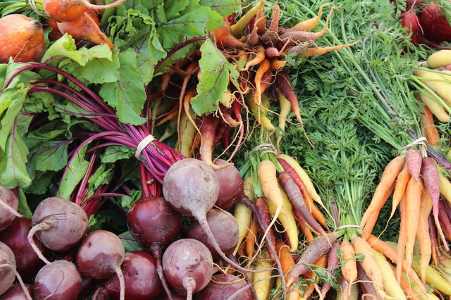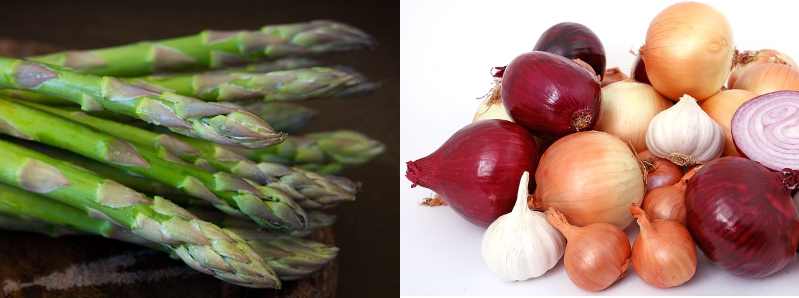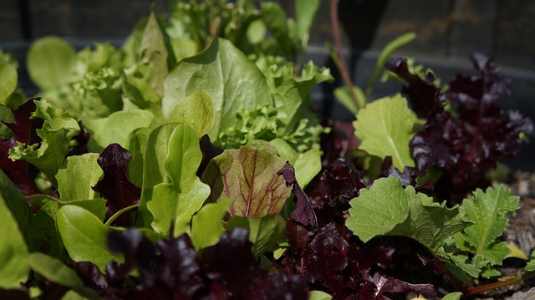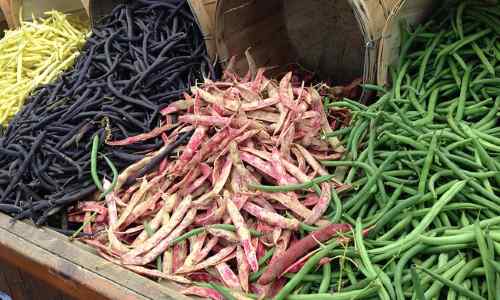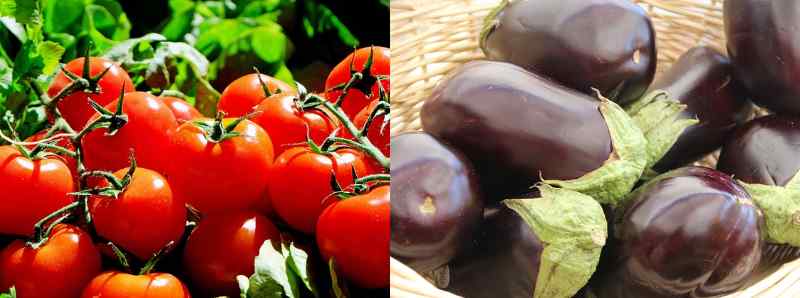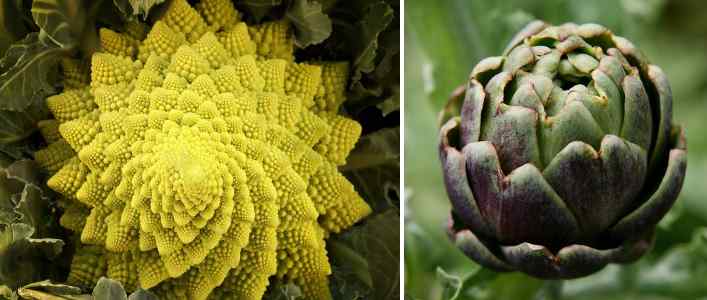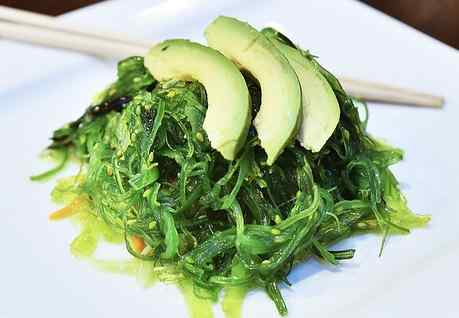Types of Vegetables: Different Kinds of Vegetables With Their Picture and Name
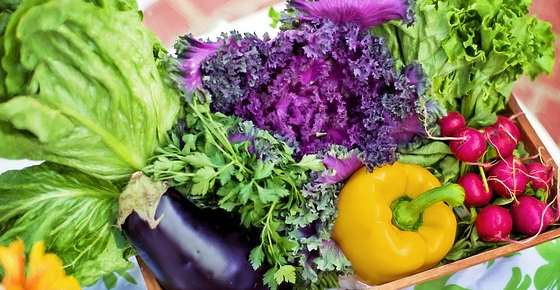
The are many types of vegetables that have different colors and flavors. The different types of vegetables are grouped together depending on which part of the plant is eaten. Of course, it is difficult to categorize each vegetable exactly. Some types of vegetables can fall into a number of categories when different parts of the plant are edible. For example, both the root and leaves of beetroot are edible.
This article has a list of different types of vegetables that we commonly eat. You will also find out about the nutritional values of these vegetable varieties.
Types of Root and Tuberous Vegetables (With Pictures and Names)
Root vegetables and tuberous vegetables are part of the staple diet of many people. Roots and tubers are generally vegetables that have carbs such as starches and sugars.
Let’s look at some of the most popular varieties of root vegetables, starting with types of tuberous vegetables.
Potatoes

Potatoes
Potatoes (Solanum tuberosum) are a starchy root vegetable that are among the most popular varieties of vegetable.
There are numerous varieties of potatoes with Russet, Yukon Gold, and Marcy being popular varieties. Potatoes generally have a white to yellow flesh and brown skin. You can also buy purple potatoes.
You may be surprised to learn that potatoes contain valuable nutrients. For example, one large baked potato can contain nearly 40 mg of vitamin C, which is 64% of your daily needs. Eating the potato with its skin gives you 7 g of fiber which is nearly 30% of your fiber requirements. (1)
The amount of carbs in one potato may not be as much as you expect. A 100 g serving of potatoes only contains 21 g of carbohydrates. This is about the same number of carbs as you would find in many types of beans.
Learn more about the different varieties of potatoes.
Sweet Potatoes are a type of tuberous vegetable

Sweet potatoes
Sweet potatoes (Ipomoea batatas) are an extremely nutritious root vegetable that is sweet and tasty.
Despite their name, sweet potatoes aren’t a true variety of potato. They usually have a long oval shape that tapers to a point. Their flesh is white to dark orange, depending on the type of sweet potato.
One of the reasons to eat sweet potatoes is that they are not a fattening food. A medium-sized sweet potato contains just 103 calories and nearly 4 g of fiber. Sweet potato also contains vitamins C, B6, and is one of the best dietary sources of vitamin A. (2)
The most impressive nutritional factor of sweet potato is its high levels of beta-carotene. This important antioxidant is essential for good vision, brain function, and lowering your risk of chronic disease. (3)
Another type of sweet potato are the purple varieties. Types of purple sweet potatoes contain powerful antioxidants called anthocyanins. (4)
All varieties of sweet potato are very versatile. You can boil them, mash them, fry them, or bake them whole.
Beets

Beets
Beets (or, beetroot) is another example of a delicious root vegetable that is extremely good for you.
The most popular variety of beet is the classic dark-purple or red variety. However, you can also buy golden beets, pink beets, and even striped beets.
Beets are a very low-calories type of root vegetable. A 100 g serving of beets only contains 43 calories. Beets are also a type of sweet vegetable as they contain nearly 7% sugar and plenty of fiber. The root vegetable is also a good source of other nutrients, vitamins, and minerals. (5)
Some studies indicate that juicing raw beetroot is a good way to help manage high blood pressure. This is because beets contain nitrate which helps improve blood flow. (37)
Carrots

Carrots
Carrots are another sweet type of root vegetable, and although we mostly think of carrots as an orange root vegetable, they come in a wide range of colors. You can buy purple carrots, black ones, red varieties, and yellow carrots.
One thing in common with all types of carrots is that they are rich in antioxidants. The main antioxidant in carrots is beta-carotene which converts into vitamin A in your body. (6)
All varieties of carrots are low in carbs and fat and high in vitamins, minerals, and fiber. Carrots have good amounts of vitamins A, C, K, and B-group vitamins. Because there are only 25 calories in a medium-sized carrot, they are a great vegetable to eat if you are trying to lose weight. (7)
The best way to maximize the nutritional value of carrots is to cook them with a little olive oil. This helps your body absorb more of the nutrients, especially beta-carotene, to boost the antioxidant levels. (8)
Ginger
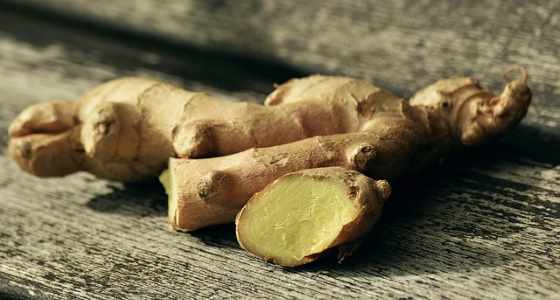
Ginger
Ginger is a type of root vegetable that we often use as a spice or herb to flavor Asian meals.
Ginger is not as nutritious as the other root vegetables mentioned in this list. However, a 1-oz. piece of raw ginger contains trace amounts of most vitamins and minerals. (9)
The main nutritious benefits of ginger come from medicinal compounds called gingerols and shogaols. These are powerful phytochemicals that have antioxidant, anti-nausea, and anti-inflammatory properties. (10)
Other types of root and tuberous vegetables
Turnips are large round root vegetable that have a lot of vitamin C. Popular ways of eating turnip include mashed, boiled, or as a tasty ingredient in stews and soups.
Parsnips are a long white type of root vegetable that resemble the shape of carrots. Many people enjoy roasted parsnips where they take on a nutty flavor.
Jerusalem artichokes are edible tubers that have a sweet taste when cooked. However, they are not to be confused with “true” artichokes – a type of flower vegetable.
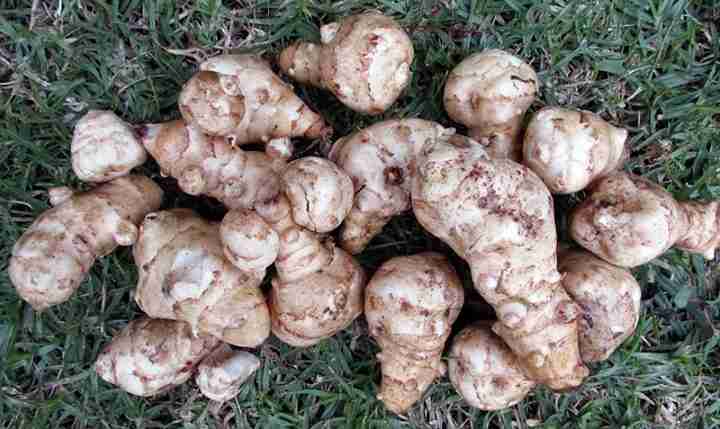
Jerusalem artichokes
Bulb and Stem Types of Vegetables
Let’s look in detail at other types of vegetables where the bulbs and stems are the edible part.
Garlic

Garlic
Garlic is one of the most popular varieties of bulb vegetables that is well-known for its pungent aroma and taste.
It is difficult to put garlic into a specific classification of vegetable. Some call it a root vegetable whereas others refer to it as an herb used in cooking.
Three cloves of garlic contain small amounts of protein, vitamins, and minerals and a tiny amount of fiber. (11)
The most outstanding part of garlic’s nutritional profile is its medicinal compound called allicin. This sulfur-based chemical has anticancer and antimicrobial properties. Eating garlic may also help to lower blood pressure. (12)
Onions
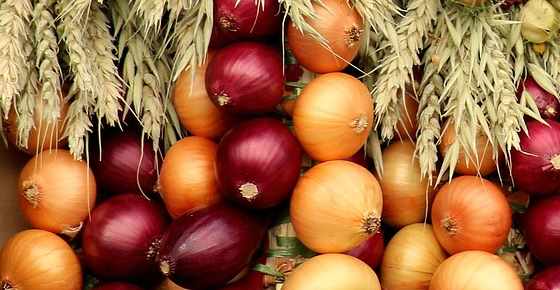
Onions
There are many varieties of onions, and you can use them as bulb vegetable to flavor food.
The different types of onions include yellow varieties, white onions, red onions, shallots, and scallions (sometimes called green onions or spring onions).
One medium-sized onion contains 44 calories per 100 grams. Onions also contain good amounts of vitamin C and B-group vitamins. The tubular leaves of green onions are also rich in vitamin K. (13, 14)
This type of vegetable contains a range of unique antioxidants called flavonoids. Studies have shown that these help to protect against a number of chronic diseases. (15)
Asparagus

Asparagus
Asparagus is a type of green stem vegetable that many people call the tastiest vegetable on the planet.
The nutritional profile of asparagus is quite impressive, especially its levels of vitamin K. For example, 5 medium-sized asparagus stems contain 33 mcg of vitamin K, which is about 40% of your recommended daily intake (RDI). (16)
This serving of 5 asparagus stems contains 16 calories and 1.7 grams of fiber. Asparagus is also low in carbs and contains moderate amounts of vitamins and minerals.
Celery

Celery
Celery is a low-calorie stem vegetable and is a great vegetable to snack on.
Nutritional data on celery shows that one large stalk or stem only contains 9 calories. This long stalk contains a gram of fiber, which is 4% of your RDI. Because celery is mostly water (95%), you can snack on this vegetable without worrying about putting on weight. (17)
The mineral and vitamin profile of celery is also impressive. A large celery stalk contains 23% of your vitamin K RDI. You also get some vitamin A, C, folate, and vitamin B6. Celery also has trace amounts of most important vitamins.
Other varieties of bulbs and stem vegetables
Leeks are closely related to onions and could be classed as a bulb or stem vegetable. The sweet taste of chopped leek is a great addition to soups or stews.
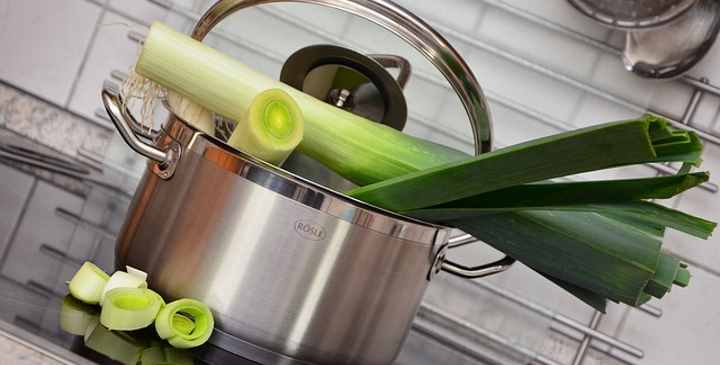
Leeks
Fennel is a vegetable with a large oval bulb that has a taste similar to anise. Its bulb, stems, flowers, and seeds are all used as ingredients in meals.

Fennel
Varieties of Leafy Vegetables
Leafy vegetables are an important source of nutrients. Many varieties of green leafy vegetables can be eaten raw in salads or boiled as an accompaniment to food.
Some root vegetables such as beets and dandelion produce edible green leaves that are also very nutritious.
Cabbage
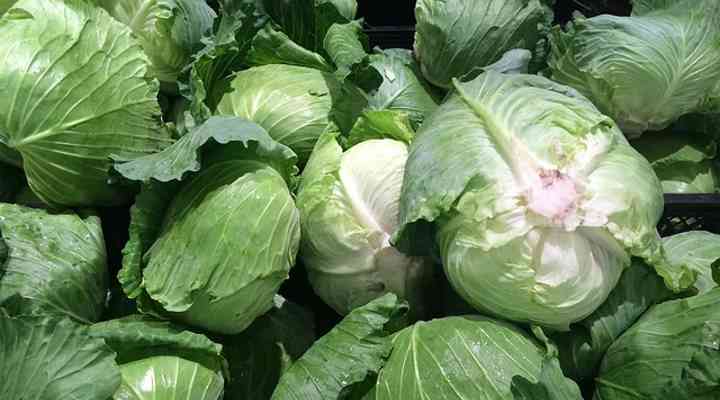
Cabbages
Cabbage is an example of a large leafy vegetable that can grow to the size of a soccer ball.
There are many types of cabbage that include green cabbage, red cabbage, and savoy cabbage.
Cabbage is also a type of cruciferous vegetable, and this family includes some types of leafy vegetables and flowering vegetables (i.e. broccoli and cauliflower).
A cup of chopped cabbage contains just 22 calories, 5 g of carbohydrates, and 2.2 g of fiber. This makes cabbage one of the top leafy vegetables when it comes to its fiber content.
Cabbage also contains an impressive amount of vitamin K with a massive 67 mcg (85% RDI) in a cup of chopped vegetable leaves. (18)
Spinach is a type of green leafy vegetables

Spinach
Spinach may be one of the healthiest varieties of leafy vegetables you can eat.
Spinach is a nutrient-dense vegetable that has many benefits. For example, just one cup of spinach contains 108% of your vitamin K RDI. Spinach is also rich in vitamin A, C, and folate. Spinach also contains moderate levels of all essential minerals. (19)
Brussels sprouts
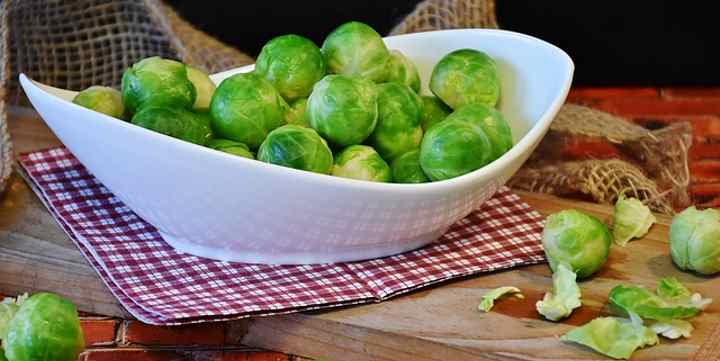
Brussels sprouts
Brussels sprouts are another type of cruciferous vegetables that are grouped in the leafy vegetable variety.
These small leafy green vegetables are a storehouse of vitamins, minerals, and fiber. In fact, just a cup of Brussels sprouts contains 3.3 g of fiber which is 13% of your RDI. This serving of Brussels sprouts also contains 125% of your daily vitamin C requirements.
What’s more, these leafy vegetables contain good amounts of protein, vitamin A, E, and B-group vitamins. You also get plenty of calcium, iron, potassium, and manganese in Brussels sprouts. (20)
Lettuce

Lettuce
There are many lettuce varieties that are perfect for creating delicious salads with.
Due to its high-water content and minimal number of calories, lettuce is a great food to eat if you are trying to lose weight. Lettuce leaves also make a great accompaniment in sandwiches or other types of meals.
A cup of shredded lettuce only contains 5.4 calories. However, you get 2,665 IU of vitamin A (53% RDI), 62.5 mcg of vitamin K (73% RDI), and 6.5 mg of vitamin C (11% RDI). Lettuce also contains potassium, magnesium, calcium, and iron. (21)
Kale

Kale
Kale is on the list of green leafy vegetables that are also classed as a superfood.
The reason why leafy kale has become such a popular vegetable is due to its nutritional profile.
For example, a cup of chopped kale contains a whopping 547 mcg of vitamin K (684% RDI), 10,302 IU of vitamin A (206% RDI), 80.4 mg of vitamin C (134%), and 1.3 g of fiber (5%). This super nutrient-dense leafy vegetable only contains 33 calories. (22)
Other types of leafy vegetables
- Bok choy
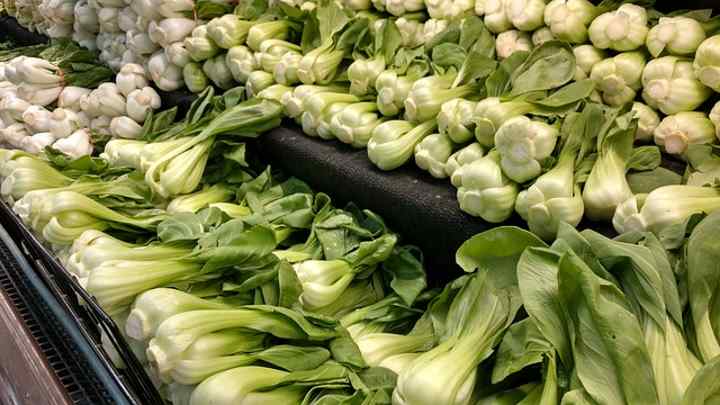
Bok choy
- Chard
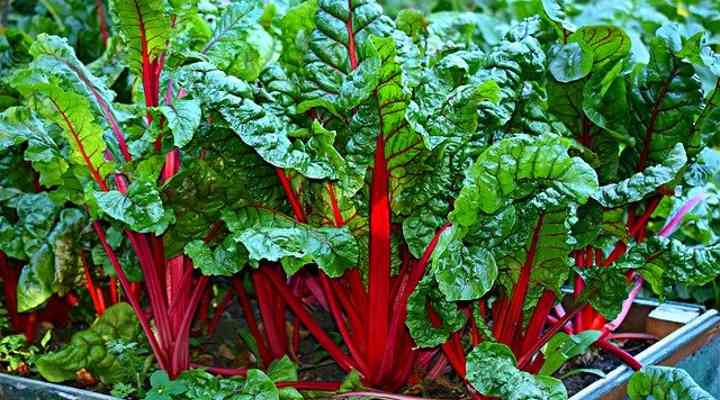
Swiss Chard
- Watercress

Watercress
Types of Podded Vegetables
Podded vegetables (or, pod vegetables) include types of vegetables that contain seed, peas, or beans encased in a pod. Legume is a term for the seeds or fruit of podded vegetables.
Beans

Soybeans
Beans are an important type of vegetable seed because they are essential sources of plant-based protein.
There are a number of types of beans that are delicious to eat. Some of the most popular bean varieties include kidney beans, pinto beans, cannellini beans, soybean, chickpeas (garbanzo beans), and black beans.
A cup of cooked kidney beans contains an impressive 15 g of protein (31% RDI) and only 225 calories. (23)
Beans are also an important source of minerals. A cup of beans contains iron (22% RDI), phosphorus (24% RDI), manganese (38% RDI), and potassium (20% RDI).
Peas

Peas
Peas are a delicious and nutritious type of vegetable seed that come packaged in a pod.
Some types of peas such as garden peas are consumed as seed vegetables without their pod. Other varieties of peas such as snow peas or sugar peas are generally eaten along with their pods.
When it comes to tiny healthy vegetables, peas are one of the top on the list. A 100 g serving of green peas gives you 5.7 g of fiber which is 22% of your RDI. However, there are just 84 calories in this serving of peas. (24)
Peas, like beans and lentils, are also good sources of plant-based protein. One cup of peas contains 8.6 g of protein, which is 17% of your daily requirements.
Lentils
Lentils are a type of legume that is also grouped together with podded vegetables.
Lentils come in a variety of colors such as red, black, and green. In many countries, lentils are one of the primary sources of non-meat protein.
Raw lentils contain 25% protein and 11% of dietary fiber. Of course, lentils are only eaten cooked. However, the cooking process doesn’t affect the protein and fiber content. In fact, lentils are in the list of the top legumes when it comes to a high-fiber nutritious food.
One cup of cooked lentils contains 230 calories, 17 g of protein, 40 g of carbs, and 15 g of fiber. (25)
Lentils are also a good source of antioxidants such as carotenoids, lutein, and zeaxanthin.
Okra

Okra
Okra is a type of green vegetable where the seeds are eaten along with the pods.
Okra pods (also called lady’s fingers) are best enjoyed in stews, soups, and gumbos where they naturally thicken the liquid.
As with all green types of vegetables, okra has a rich nutritional profile. In a 100 g amount, raw okra contains just 33 calories and 3.2 g of fiber. Due to its low number of carbs (just 7 g in 100 g), okra is a good vegetable for diabetics to enjoy. (26)
Types of Vegetables That Are Actually Fruits
On the list of the most popular vegetables are some types of plants that are, botanically speaking, classified as fruits, but used in the culinary world as vegetables.
Let’s look at some of the most common vegetables that are classified as fruits.
Tomatoes
Tomatoes are an important type of vegetable (or technically fruit) that are an integral part of most cuisines in the world.
There are many types of tomatoes that come in all shapes, sizes, and colors. There are small cherry tomatoes, medium-sized plum tomatoes, and large beefsteak tomatoes. Some varieties of tomatoes are golden yellow and others are dark green when mature (Kumato).
Tomatoes contain vitamins A, C, E, and K, as well as most B-group vitamins. All varieties of tomatoes have moderate amounts of minerals and some fiber.
The benefits from tomatoes come from the antioxidant called lycopene. (27)
Cucumbers

Cucumbers
Technically, cucumbers are a variety of fruit. However, we mainly use fresh cucumber as a nutritious type of vegetable.
There are thought to be over 100 varieties of this type of long green vegetable. Cucumbers are consumed fresh in salads or pickled, where they are referred to as gherkins.
Cucumbers are low in calories, fiber, and protein. However, they contain good amounts of important vitamins and minerals as well as antioxidants. The best way to eat cucumber is with their peel on to increase your fiber intake. (28)
Eggplants
While we think of eggplant as a large purple-skinned type of vegetable, it is actually a fruit.
Eggplants belong to the nightshade family of plants that also include potatoes, bell peppers, and tomatoes.
The main nutritional benefits of eggplants come from the fiber content and antioxidants of their dark-colored skin. One cup of chopped eggplant contains nearly 3 g of fiber (11% RDI) and just 4.7 g of carbs. There are only 19 calories in this serving of eggplant. (29)
The dark skin of eggplant means that it is rich in antioxidants such as anthocyanins. (30)
Other varieties of fruits we consume as vegetables
Squash is a member of the gourd family that also includes pumpkins and zucchini (courgette). Squash vegetables contain nutrients such as vitamin A and C. (31)
Avocados are botanically a type of fruit that are often used as a vegetable. They are a good source of protein, vitamins, fiber, and fats. (32)
Types of Vegetables that are Actually Edible Flowers
Some types of plants produce edible flowers. However, you may not think of these vegetable varieties as your typical type of flower.
Here are some of the most common vegetable flowers that we consume:
Broccoli

Broccoli
Broccoli is actually a cruciferous type of vegetable that grows green florets.
As with many green vegetables, broccoli is a good source of many nutrients. In fact, broccoli is such a nutritious type of vegetable that it is on the list of superfoods.
For example, half a cup of cooked, chopped broccoli florets contains minerals such as calcium, iron, and potassium. This amount of broccoli has impressive levels of vitamins. You get 24% of your vitamin A RDI, over 80% of your vitamin C RDI, and a massive 138% of vitamin K! (33)
Cauliflower

Cauliflowers
As its name suggests, cauliflower is a type of edible flower vegetable that is grouped together with cabbage, Brussels sprouts, and broccoli.
The most common variety of cauliflower is the type with white florets. However, other interesting varieties of this vegetable flower include green cauliflower, orange cauliflower, Romanesco cauliflower, and purple cauliflower.
You can eat cauliflower raw, boiled, pan-fried, and, everyone’s favorite – cauliflower cheese.
A 100 g serving of cooked cauliflower only contains 23 calories. This cruciferous vegetable is low in carbs, fat and high in fiber. It also contains good amounts of necessary vitamins and minerals. (34)
Artichoke

Globe Artichoke
Artichoke flowers are the edible part of the artichoke plant and look like a round ball on top of the stem. This is a reason why it is also called the globe artichoke.
The type of artichoke flower shouldn’t be confused with the Jerusalem artichoke which is a type of root vegetable.
Artichokes provide a good number of vitamins and minerals. Possibly, the most outstanding nutritional value of artichoke flowers is its range of antioxidants.
It is claimed that the artichoke plant is one of the top vegetables in terms of total antioxidant levels. Artichokes contain antioxidants such as apigenin, luteolin, and cynarine. (35)
Types of Fungi
Fungi are not classified as a type of vegetable, fruit, or any other kind of plant. They are a particular type of food in a class of their own. However in the culinary world many people use them as vegetables.
There are a number of types of edible fungi that are delicious and very good for you. Learn more about the best varieties of mushrooms to eat.
Sea Vegetables
Sea vegetables are types of edible seaweed that some people say are some of the healthiest vegetables. One example of it is kelp. Other examples include nori, wakama, dulse and spirulina.
One of the reasons why various types of seaweed are considered very good for you is due to their high levels of phytonutrients. Studies show that sea vegetables contain unique benefits not found in “terrestrial” food. Seaweed is high in vitamins A, B, C, and E as well as being an important iron source for non-meat eaters. (36)
Related articles:

